As the Bundesliga season reaches its climax, one fixture stands out among the rest – the legendary “Klassiker” clash between FC Bayern Munich and Borussia Dortmund. Steeped in history and rivalry, this match has transcended its status to become a global spectacle, and this edition promises to be no different.
Despite Bayern’s dominance in recent years, this season has seen a shift in the Bundesliga narrative, with Bayer Leverkusen emerging as the frontrunners, holding a commanding lead at the top of the table. For Bayern, accustomed to lifting the title season after season, the prospect of relinquishing their crown looms large, adding an extra layer of significance to this showdown against their arch-rivals. The Allianz Arena will be brimming with anticipation as both teams vie for supremacy, eager to claim the coveted Klassiker bragging rights.
With Bayern boasting an unparalleled record of 32 Bundesliga titles, their pedigree is unquestionable. However, Dortmund, with their five league titles, have consistently posed a formidable challenge to Bayern’s dominance, particularly since the 1990s. As the two giants of German football prepare to lock horns once again, the stage is set for a tactical battle of epic proportions, promising thrills, drama, and footballing brilliance. This tactical analysis piece in the form of a tactical preview will provide answers to those tactical questions as we guide you through both teams’ tactics with analysis.
Line-Ups
In the forthcoming clash between FC Bayern and Borussia Dortmund, the probable line-ups are shaping up as follows.
Bayern are expected to deploy Ulreich in goal with a defensive lineup consisting of Kimmich, De Ligt, Dier, and Davies. Pavlović and Goretzka are anticipated to control the midfield, while Sané, Müller, and Musiala will provide the attacking inputs, with Kane leading the line. However, they will be without Boey, Buchmann, and Sarr due to injury, with players like Coman and Guerreiro facing doubts.
Conversely, Dortmund are likely to field Kobel in goal, supported by Ryerson, Süle, Schlotterbeck, and Maatsen in defence. Özcan and Can are expected to anchor the midfield, while Malen, Brandt, and Sancho provide the creative spark, with Füllkrug leading the attack. Bamba and Sabitzer are unavailable, with doubts surrounding Bensebaini and Haller.
Both teams are under the guidance of top coaches, with Thomas Tuchel leading Bayern and Edin Terzić at the helm for Dortmund.
Bayern’s Shift in Approach
FC Bayern’s approach under Tuchel has shown flexibility and adaptability, as seen in their recent tactical adjustments. Switching from a back four to a back three proved effective, with Goretzka seamlessly transitioning into a new role as the left centre-back in possession. This alteration has added a dynamic dimension to Bayern’s build-up play, with Goretzka excelling in his ability to drive forward with the ball from deep positions.
Key to this tactical shift is the emergence of Pavlović in midfield, whose adeptness at handling pressure has provided stability in the centre of the pitch. Pavlović’s impressive pressure handling highlights his importance in Bayern’s new structure.
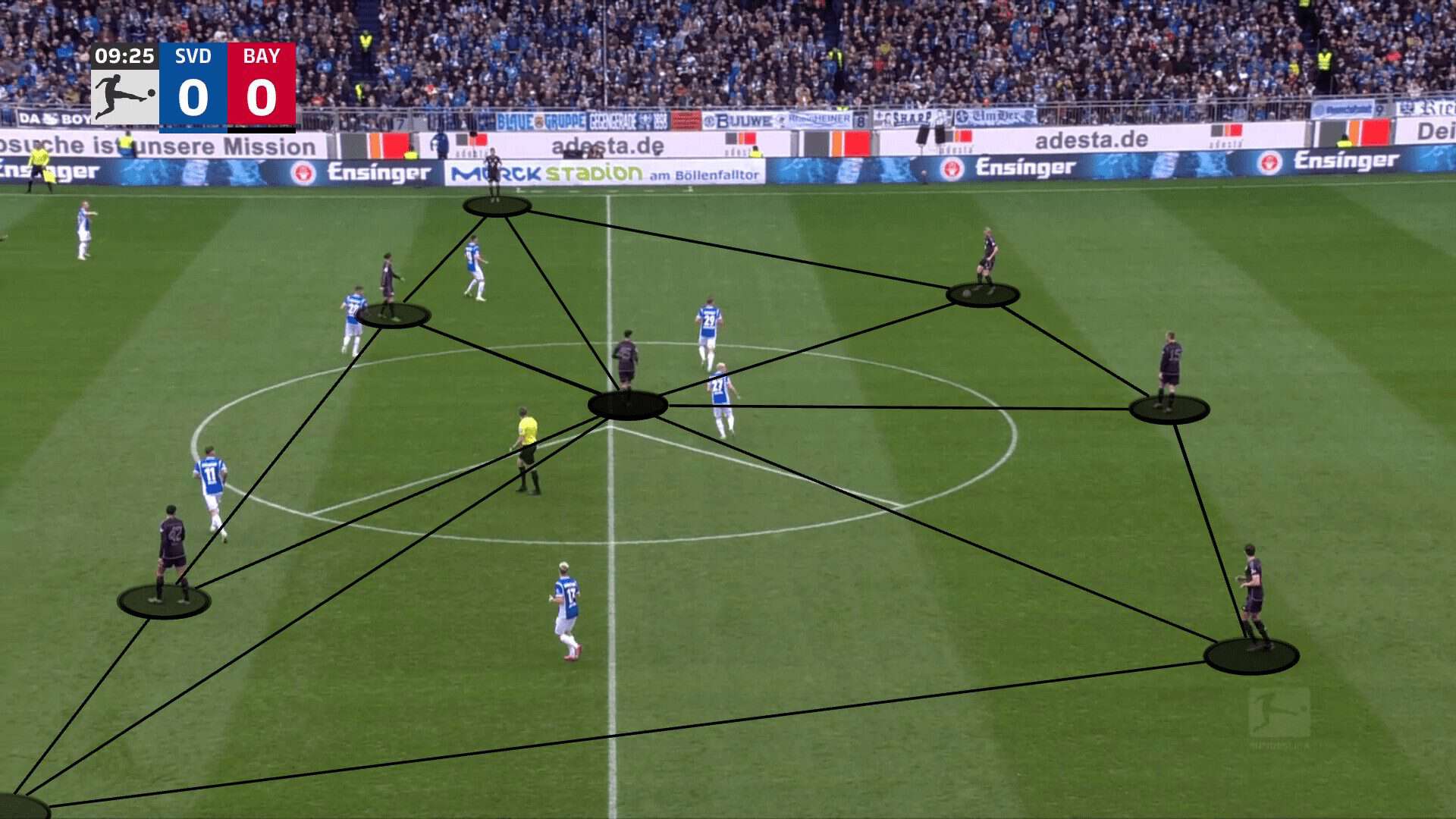
In attack, Bayern’s full-backs adopt an aggressive high and wide positioning, offering width and versatility to the team’s attacking movements. The nominal No. 10, typically Müller, partners with Kane upfront, allowing the wingers Musiala and Sané to drift infield and occupy central areas. This strategic setup ensures fluidity in Bayern’s attacking play, with options for both direct runs and intricate combinations among the front players.
Bayern’s approach combines tactical innovation with individual player strengths, providing advantages in flexibility and attacking variety. However, the reliance on positional interchange and offensive rotations may expose vulnerabilities in defensive transition if not executed with precision.
FC Bayern’s Attacking Approach
FC Bayern’s attacking approach is characterised by dynamic movement and intelligent positioning to create numerical advantages and exploit spaces in the opponent’s defence. One key aspect is their ability to maintain a numerical superiority during build-up play, even when facing opposition with a front two pressing system. This allows the wide centre-backs to carry the ball forward and initiate attacks, effectively stretching the opposition’s defensive structure.
In the attacking phase, Bayern’s players constantly move to destabilise the opposition’s defence. If Goretzka faces pressure, the full-backs push forward to provide support, forcing the opposition’s full-backs to advance and creating gaps in the defensive line. This movement also serves to draw out the marking centre-backs, creating space for the attacking players to exploit.
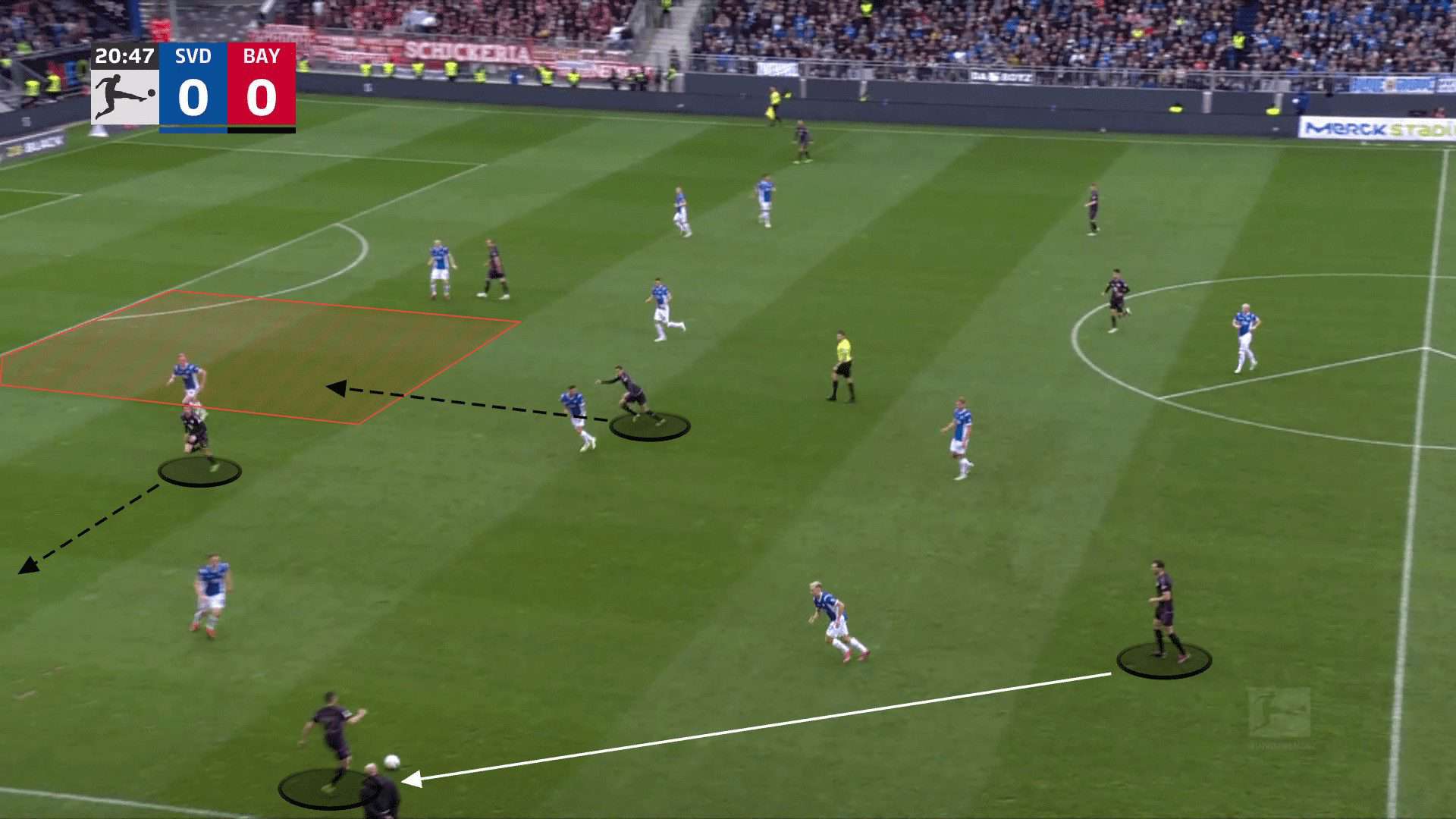
An essential component of Bayern’s attacking strategy is the role of Pavlović in midfield. His ability to receive the ball under pressure and maintain possession provides a crucial link between different areas of the pitch. With Pavlović’s composure and distribution skills, Bayern can seamlessly switch play from one wing to another, effectively stretching the opposition’s defence and creating opportunities to penetrate centrally or exploit spaces out wide.
FC Bayern’s Defending Approach
FC Bayern’s defending approach under Tuchel has evolved to prioritise organisation and compactness, particularly when out of possession. They often transition into a 4-4-2 formation to make space tight and restrict the opponent’s attacking opportunities. This defensive shape provides stability and allows for effective pressing when the opposition has the ball.
One key aspect of Bayern’s defensive strategy is the role of Thomas Müller. As an experienced player with a keen tactical understanding, Müller acts as the pressing coordinator from the front, organising the defensive efforts of the team. His communication and gestures help guide his teammates, ensuring coordinated pressing and defensive cohesion. However, in situations where Müller is deeper on the pitch, verbal communication becomes essential.
Dortmund’s Shift in Approach
Dortmund has undergone a shift in approach following a challenging first half of the season, marked by strategic adjustments and personnel changes. With the addition of new assistants Sven Bender and Nuri Şahin, alongside the loan signing of Ian Maatsen, Dortmund aimed to address shortcomings and enhance flexibility, particularly in build-up play.
One noticeable change is Dortmund’s adoption of a flat 4-1 formation during build-up phases, with Emre Can assuming the role of the lone holding midfielder in front of the defensive line. This setup allows for the central defenders, typically Niklas Süle and Nico Schlotterbeck, to distribute long vertical passes or initiate attacks by releasing the full-backs down the flanks.
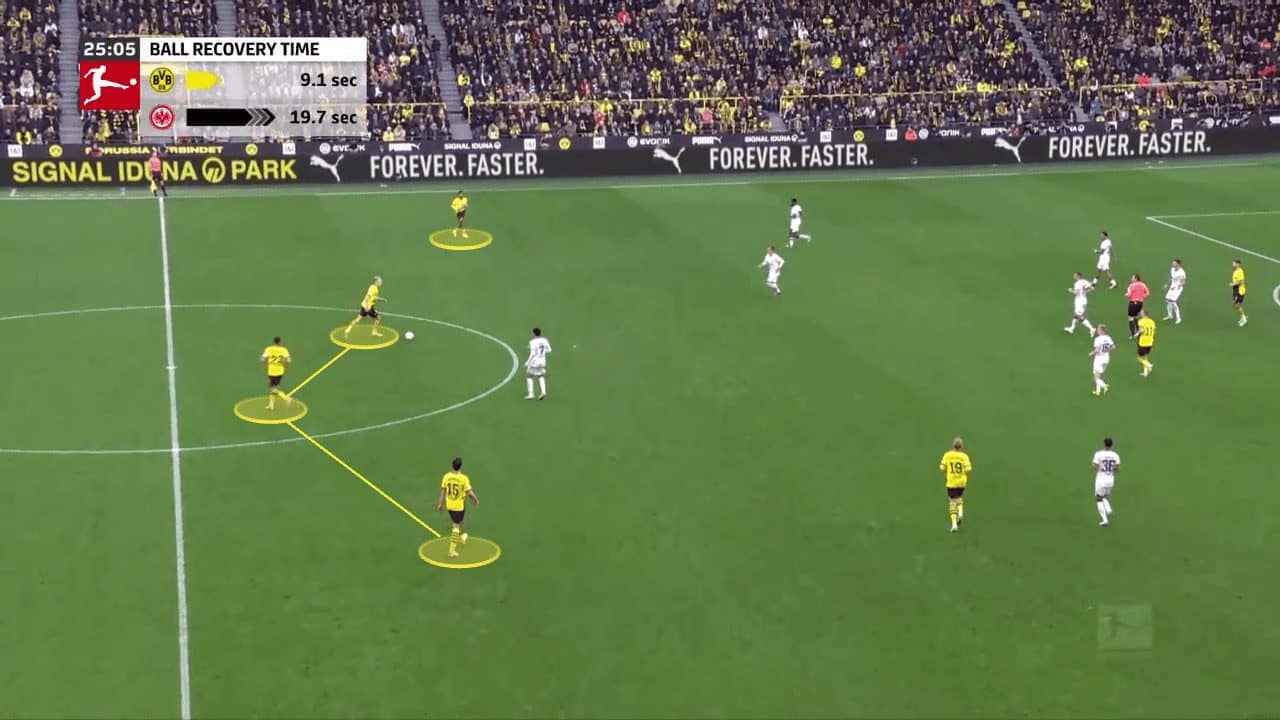
However, while this approach offers potential benefits in advancing play, it also poses challenges that Dortmund must navigate to optimise its effectiveness.
Dortmund’s Build-Up Play
Dortmund’s build-up play revolves around exploiting two-v-two situations on the flanks in collaboration with their wingers, aiming to penetrate the opposition’s penalty area through crosses or dribbles. This approach prioritises speed and volume of attacks over the quality of chances, often leading to rapid forward movements orchestrated by dynamic wingers like Donyell Malen, Jadon Sancho, or Karim Adeyemi. Malen’s prolific goal-scoring record, with 11 Bundesliga goals this season, frequently stems from these fast-paced assaults.
However, Dortmund’s strategy encounters difficulties against deep-lying defences or high-pressing opponents, where the risk associated with vertical passes from the centre-backs and the advanced positioning of full-backs becomes more pronounced. To address these challenges, Emre Can frequently drop deeper to form a back three alongside the centre-backs, utilising his expertise as a central midfielder to navigate tight spaces and enhance defensive stability, boasting impressive Pressure handling.
Moreover, left-back Ian Maatsen shifts centrally to provide defensive cover. At the same time, the box-to-box midfielder, typically Marcel Sabitzer, drops deeper to offer additional support and contribute to the team’s balanced build-up play with his excellent distribution skills. These tactical adaptations aim to mitigate vulnerabilities in Dortmund’s build-up approach and maintain a cohesive midfield presence to facilitate smooth progression of play.
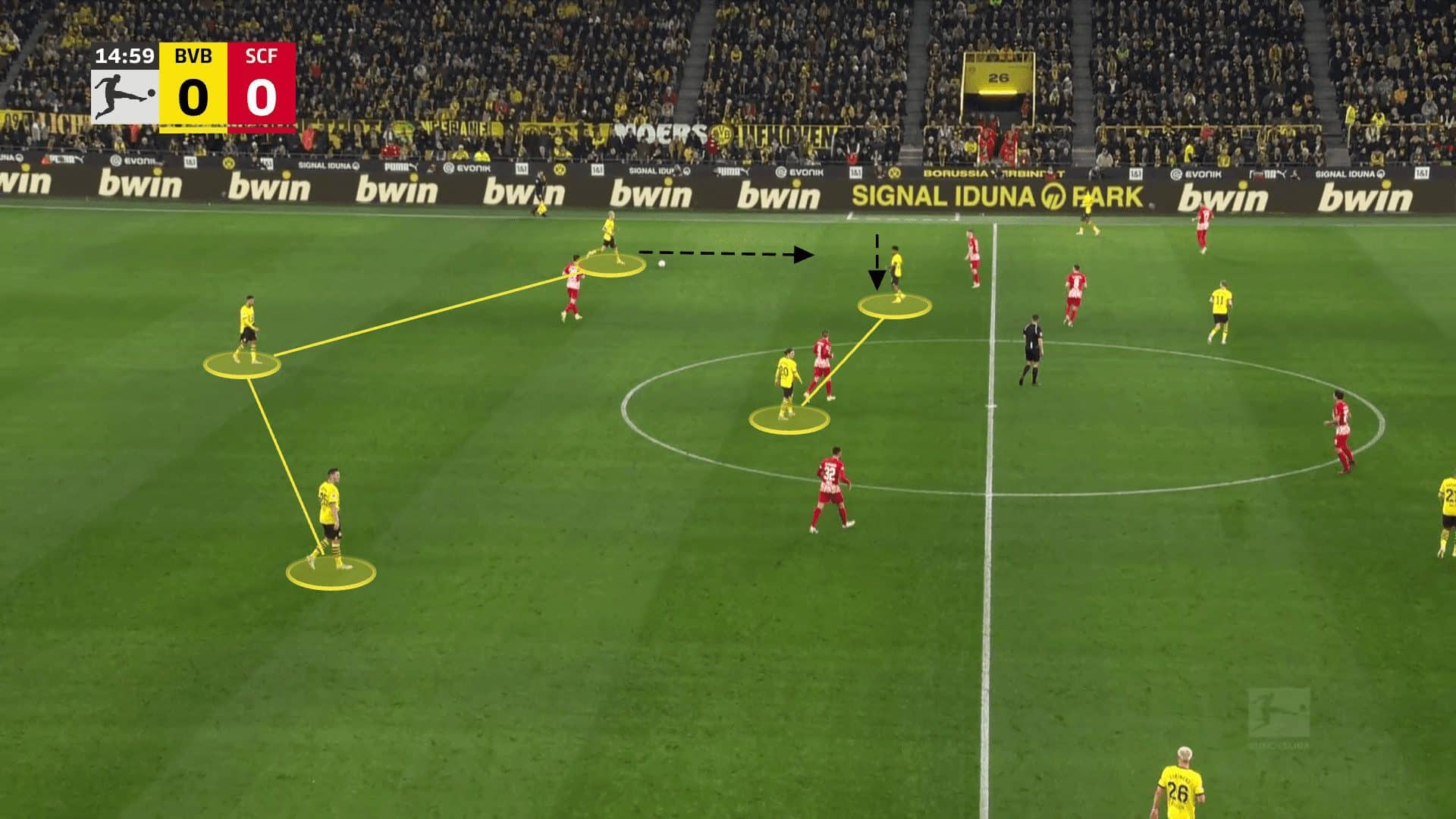
Sabitzer’s absence presents a significant challenge for Terzić ahead of Der Klassiker, as the Austrian midfielder’s versatility has been instrumental in Dortmund’s tactical setups, particularly in transitioning to a 3-2 build-up system. His adeptness at fulfilling various roles has provided stability and fluidity to the team’s gameplay. In the recent matches, Dortmund encountered difficulties operating in their standard 4-1-4-1 formation until they adjusted by dropping Brandt deeper alongside Can. This tactical adaptation proved effective, enabling Dortmund to assert control, retain possession, and create opportunities to exploit the opposition’s defence.
Given the potential vulnerabilities associated with a more attacking setup against Bayern, with the Brandt-Reus partnership potentially leaving Dortmund exposed, the inclusion of Salih Özcan as Sabitzer’s replacement becomes a probable scenario. However, Özcan will need to seamlessly integrate into the midfield setup to ensure Dortmund’s cohesion and effectiveness in both defensive and offensive phases of play.
Dortmund’s Counterpressing and Counter-Attacks
Dortmund’s counterpressing strategy was on full display in recent matches, exemplifying their tactical prowess and ability to capitalise on turnovers. Against a pressing opponent, Dortmund effectively utilise their defensive structure to regain possession and initiate swift attacking transitions. This was evident in their match against Freiburg, where Emre Can dropped deep to retrieve the ball, initiating a sequence of coordinated movements to evade pressure and advance into the final third.
Despite initial challenges, Dortmund’s relentless pressure and quick reactions led to turnovers, allowing them to exploit gaps in the opposition’s defence and create scoring opportunities.
This dynamic approach was further demonstrated in their match against Frankfurt, where Dortmund capitalised on turnovers to swiftly transition from defence to attack, ultimately resulting in goal-scoring opportunities and effective execution in the final third.
Dortmund’s counter-attacking prowess is a formidable weapon in their arsenal, fueled by the blistering pace of their players and the astute link-up play of Füllkrug. While options like Moukoko and Malen offer to speed up front, Terzić has favoured Füllkrug for his pivotal role in Dortmund’s tactics.
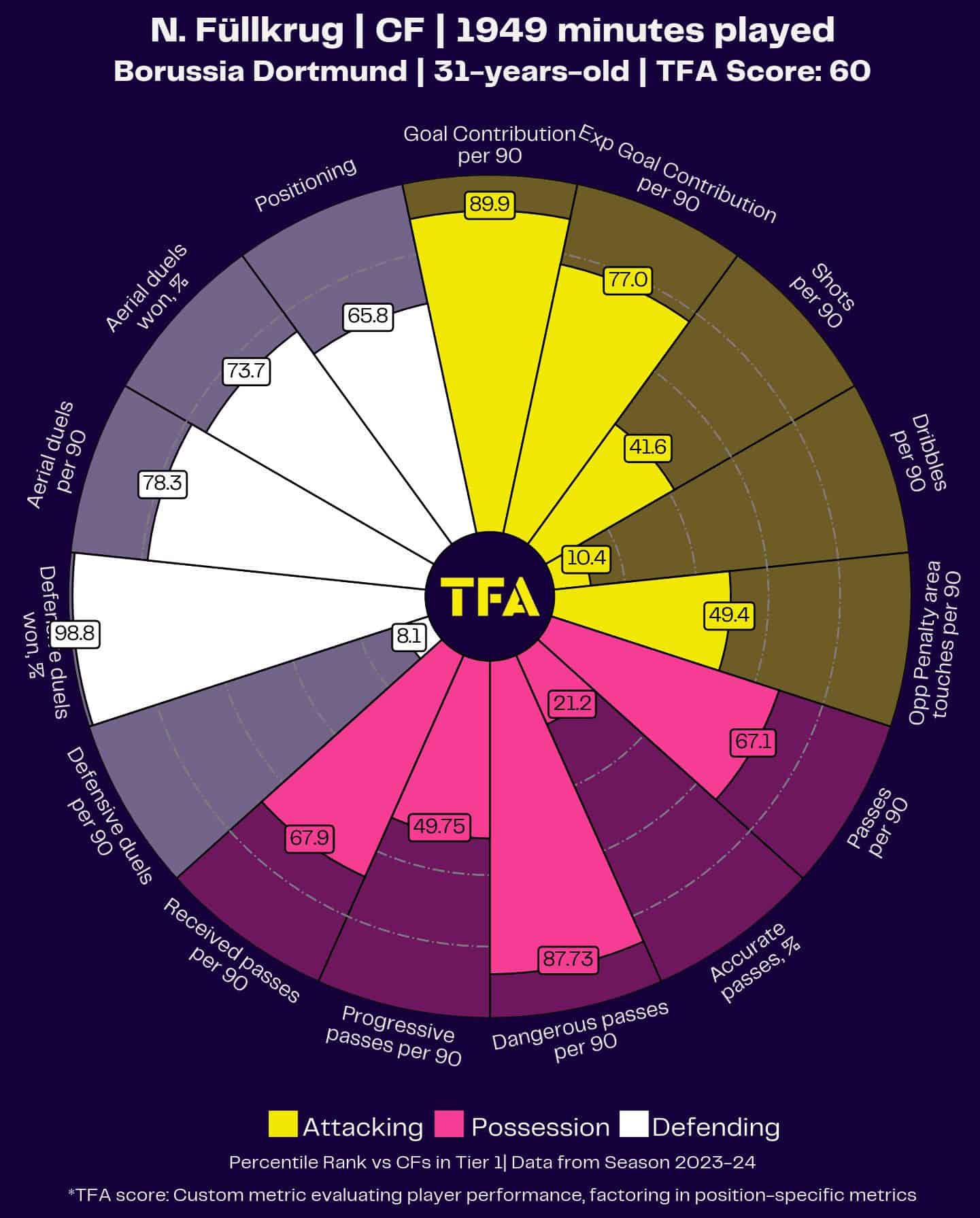
Serving as a focal point, Füllkrug not only poses a goal threat but also facilitates the involvement of Dortmund’s dynamic wingers, ensuring they are brought into play effectively. His ability to hold up the ball and create scoring opportunities for teammates is unparalleled, reflected in his impressive tally of assists, which surpasses his goal-scoring record.
Potential Match Plans
Bayern is likely to anticipate Dortmund’s starting formation of 4-2-3-1, which could involve a build-up strategy with either a 4-1 or 3-2 approach. If Dortmund opts for a back four and one holding, Bayern may counter with a flat 4-4-2, aiming to pressure their full-backs with close support from the wingers. Alternatively, if Dortmund deploys three deep with two in front, Bayern’s centre may not be adequately covered, allowing them to focus on pressing the flanks. Tuchel may devise tactics to congest the midfield, such as instructing the wide player to move inside on the opposite side of the ball’s movement. Ultimately, the match will hinge on the coaches’ strategies and the execution by the players on the field.
Dortmund’s strategy out of possession has shown adaptability, typically starting in a 4-2-3-1 formation but adjusting based on the opposition. For instance, Malen often presses aggressively on the right while the left side focuses on defensive coverage. In recent matches, Dortmund has also transitioned to a back three, reinforcing their defence against formidable opponents like Bayern. Against Bayern’s attacking prowess, Dortmund may adopt a defensive setup resembling a 3-1-4-2, a tactic observed in previous matches against strong opponents. Leveraging the defensive successes of teams like Freiburg and Leverkusen against Bayern could provide Dortmund with a blueprint for defensive solidity in Der Klassiker.
Conclusion
The upcoming clash between FC Bayern and Borussia Dortmund promises to be an enthralling tactical battle. Both teams boast versatile strategies that have evolved throughout the season, showcasing adaptability in their approaches to both attacking and defending. With the title race heating up and bragging rights at stake in Der Klassiker, fans can anticipate a captivating showdown between two of Germany’s footballing giants.





Comments